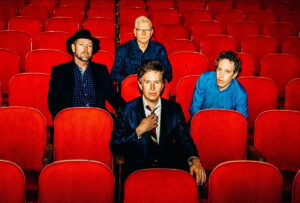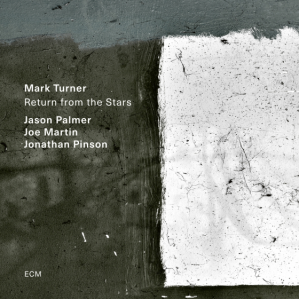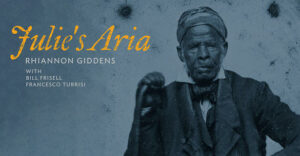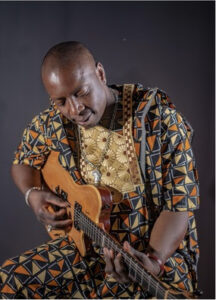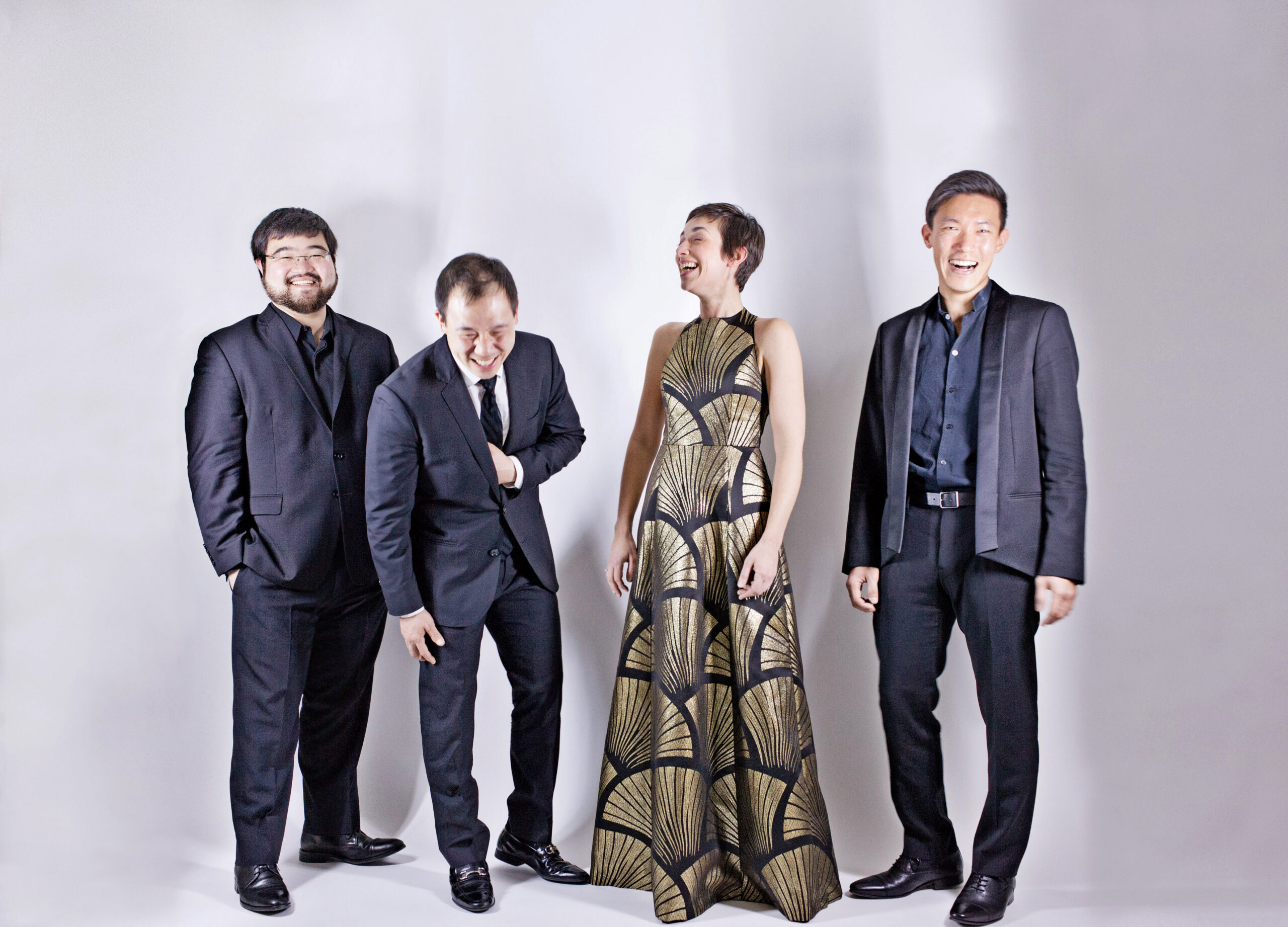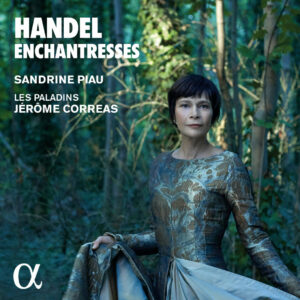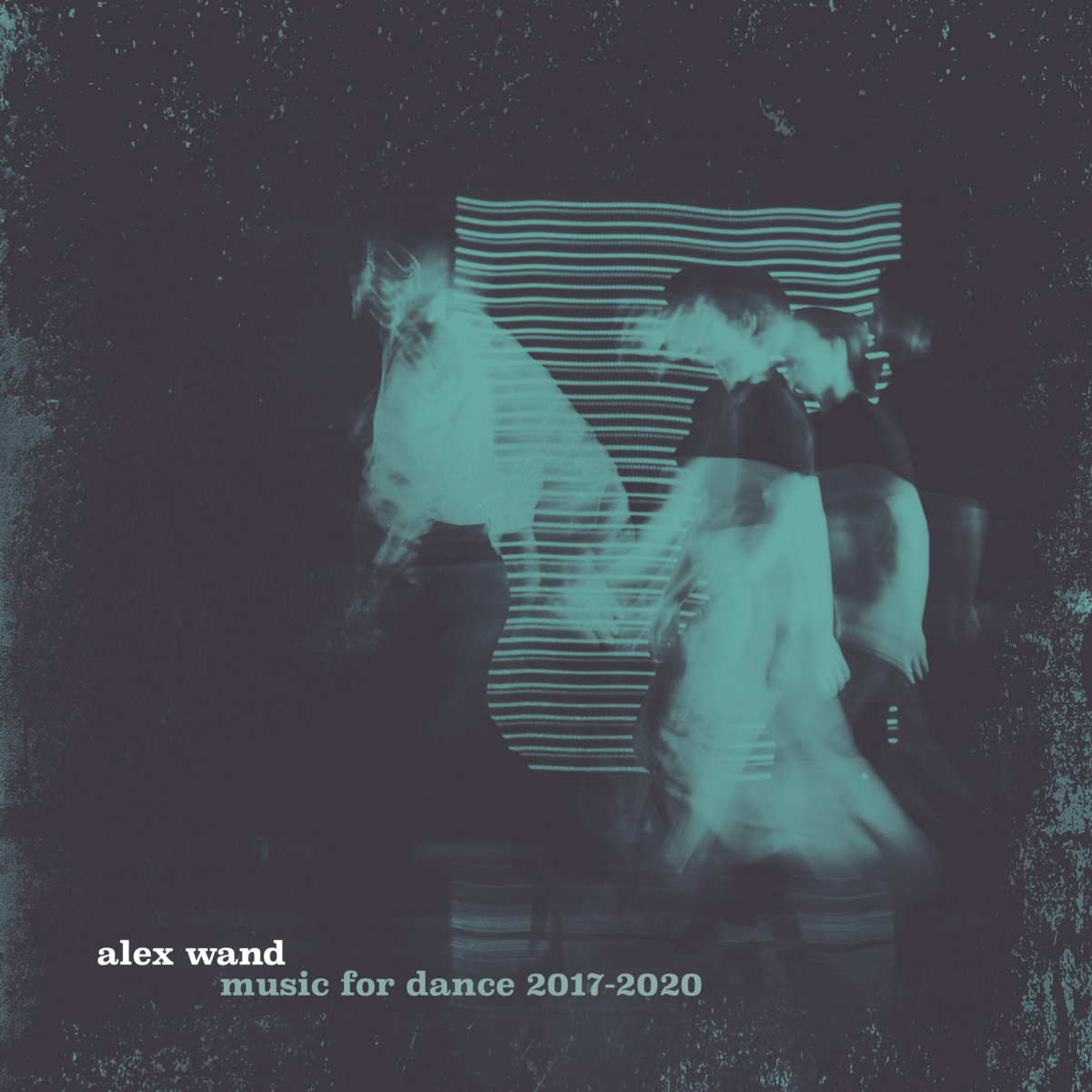
Music for Dance 2017-2020, by Alex Wand, is a new album of selected electronic instrumental music created as accompaniment for choreographed dance. Wand’s experience with the local dance community is extensive and includes residencies with the LA Dance Project, Los Angeles Performance Practice, REDCAT, and Metro Art LA. According to the liner notes, Wand has worked with choreographer Jay Carlon “ …as a collaborator on his site-specific dance theater productions and dance films…” This collection consists of eight tracks of electronic music, primarily realized using modular synths. Although Wand’s supple voice is absent from this album, the inventive sounds he creates provide an open and inviting framework for interpretive dance.
Composers working with dance companies have a distinguished history in new music. Lou Harrison often collaborated with dance choreographers during his career. John Cage famously devised the prepared piano to give his accompaniment more percussive punch, assisting the dancers to better follow the beat. The closest piece to the traditional forms of dance music in Alex Wand’s new album is Crest, track 5, which provides a repeating phrase at a brisk tempo that is mostly percussive in texture. This piece feels like dance in that it encourages movement. The rounded tones are subdued but active, and interesting harmonies develop as the repeating phrases evolve.
Out of Bounds, track 3, further explores the percussive texture but with a different expressive intent. This begins with a strong beat and rapid electronic pulse. The drum beats occasionally vary in pitch and volume so that the feeling is like being inside of a helicopter. A sine tone is heard and the rhythms change up, becoming more broadly mechanical. The pulses here are less a guide for body movement and more a framework that allows the dancer to react. Other tracks in the album encourage a similar response. Flocking, track 1, is typical with deep, sustained tones setting a warm foundation while a repeating, syncopated chirp in the higher registers convincingly evokes other worlds. There is a feeling of open grandeur to this that engages the listener while allowing the dancer full scope for interpretation.
Four Triangles features four synthetic tones with differing pitches and duration. The pitches are based on the resonant frequencies of pieces of sheet metal and the processed sounds are somewhere between a pure sine wave and a bell chime. These attractive tones blend well together and form engaging harmonies. Signal, track 7, consists of complex electronic sounds that seem to be emulating a message of some sort. Low, sustained tones compliment the beeps and boops in the upper registers. This ends dramatically as the signals fall away leaving just the lower tones. The other pieces in this album are similarly intended to give the dancers a wide canvas for expression.
Although often abstract and otherworldly, Music for Dance makes for an excellent contrast with the obvious human element that the dancer provides. Alex Wand writes: “The tracks feature fluctuating synth pulses, swirls of noise textures, and pitch-shifted recordings of planetary magnetospheres… I composed these pieces with the intent to leave room for the dance to speak and hope that this sense of spaciousness is translated to the listener as well.”
In addition to the electronic realization of his accompaniments, Wand has also experimented with physical inputs such as wireless accelerometers and contact microphones to provide a path for interaction between the movement of the dancer and the music. Music for Dance 2017-2020 adds a 21st Century sensibility to the long-standing collaboration between new music and interpretive dance.
Music for Dance 2017-2020 can be heard at Bandcamp.
Mark Turner
Return from the Stars
Mark Turner, saxophone; Jason Palmer, trumpet; Joe Martin, double-bass, Jonathan Pinson, drums
ECM Records
In recent years, saxophonist Mark Turner has appeared as a collaborator on a number of ECM recordings, including CDs with Billy Hart and Ethan Iverson. His latest, Return from the Stars, is the first quartet outing he has recorded for the label as a leader since 2014’s Lathe of Heaven. The players who join Turner are trumpeter Jason Palmer, bassist Joe Martin, and drummer Jonathan Pinson. All of the tunes are originals by Turner, and he demonstrates versatility and depth as a writer. Just as Lathe of Heaven is the name of an Ursula K. LeGuin novel, Return from the Stars references a totemic sci-fi book by Stanislav Lem. There are no electronics or sci-fi effects that suggest spaciness, but the solos of the winds and freely flowing rhythm section suggest music that aloft ascends.
The title composition has a mysterious cast, beginning with the tune outlined by trumpet and saxophone with heterophonic embellishments in both of the winds and a sotto voce rhythm section. The lines start to crisscross only to once again converge, with Martin interjecting a walking line that supplies another melody to the action. Pinson builds upon Martin’s gestures, swelling to dynamic presence. Turner is a generous collaborator, eager to showcase his colleagues alongside his own playing. Palmer is allowed considerable time to solo. His rangy and rhythmically varied one on “It’s not Alright” is a particular standout of virtuosity and taste in shaping numerous choruses. The tune also features Turner and Palmer playing fleet renditions of the tune in octaves completely together. On “Wasteland” they play a duet in rhythmic unison but in constantly shifting intervals. Martin and Pinson relate to them in an abstract fashion. Just when you think that they are off on a tangent, the group syncs together, with Martin providing harmonic underpinning and Pinson landing with him to articulate arrival points.
Several of the tunes stretch, but “Unacceptable” is the longest form, with cat-and-mouse canons leading off into overlapping winds. A melodic cell is played in intervals and then developed as a principal motive in octaves. The winds submerge at their cadences points, affording space for breaks by the rhythm section followed by solo turns. Turner’s is chromatic, vibrant in tone, and filled with scalar passages that develop and recall the chorus. The game of canons returns, followed by a languid trumpet solo and then a warm wind duet. The close is a beautiful denouement, with the wind duo slowing down and fading to pianissimo and the rhythm section equally hushed.
An intricate piece, “Unacceptable” suggests that Turner would do well to arrange some of his compositions for larger ensembles: perhaps ECM will oblige in a future recording project. In the meantime, Return from the Stars supplies the listener with plenty of fascinating music to savor.
-Christian Carey
Rhiannon Giddens, along with guitarist Bill Frisell and percussionist Francesco Turrisi, perform “Julie’s Aria” from Giddens’ first opera, Omar. Premiering at Spoleto, the opera is receiving productions at a number of prominent houses. Here is an audio stream via YouTube. Giddens is busy with myriad projects, but her singing is so compelling here: dare Spoleto offices hope for a cameo?
On June 10, World Circuit will release Les Racines, an album by Malian guitarist Vieux Farka Touré.
The third single on the album, “Oglala Kaurene,” has been given video treatment. Check out Touré’s guitar stylings, which draw upon the work of previous Malian musicians while remaining distinctive in its deployment of punchy lines and looping polyrhythms. He isn’t known as “Hendrix of the Sahara” for nothing.
Touring
May 13—Freight & Salvage—Berkeley, CA
May 14—Center for the Arts—Grass Valley, CA
May 15—Felton Music Hall—Felton, CA
May 17—Musical Instrument Museum Theater—Phoenix, AZ
May 18—Dakota—Minneapolis, MN
May 19—SPACE—Evanston, IL
May 20—Le Poisson Rouge—New York, NY
May 21—World Café Live—Philadelphia, PA
May 22—Race Street Live—Holyoke, MA
June 8—Crystal Ballroom—Somerville, MA
June 10—Infinity Hall—Norfolk, CT
June 11—StageOne—Fairfield, CT
June 12—Afrika Nyaga Fest—Providence, RI
August 4—Celebrate Brooklyn—Brooklyn, NY
April the First proved a propitious date for the New York Classical Players’ much anticipated program featuring a new collaboration – and premiere – with the Parker Quartet. In the mere twelve years since their inception, NYCP has consistently brought spirit and devotion to so much of what they do, and this early Spring concert at W83 Auditorium was no exception. In many respects, the highlight of the evening was Jeremy Gill’s joyous new work, “Motherwhere,” a concerto grosso for the Parker Quartet and NYCP. But well-worn, oft’-loved music by Tchaikovsky was also on offer, delivered with great heart. And that is how the evening began:
Opening the program as soloist in the Andante Cantabile for cello and strings, Madeline Fayette, (NYCP’s own), commanded centerstage. Forthright, with an immediate brand of lyricism, Fayette radiated warmth from her cello, upheld by a muscularity of execution. Her global tone seemed born of a seductively dark palette. While lush and nourishing was Fayette’s romantic sense, the coloring became all too similar at times. One hankered for more variety in sonority, extracted from the piano end of the dynamic spectrum. Brighter hues too, would have enhanced an admittedly emotionally satisfying reading. Conductor Dongmin Kim guided the chamber orchestra deftly, ever sensitive to Fayette’s richly etched lines. Notably, Tchaikovsky’s moments of silence were realized expertly by Fayette, aided again by the orchestra’s soft touch. At times it seemed as though conductor Kim was a little too aloof and might well have taken opportunity to invigorate the proceedings with contrasting textures and inner accompaniment parts, especially from the upper strings.
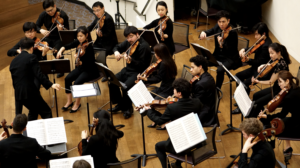
From the start, it was apparent that NYCP has an affinity for Tchaikovsky and such canonic works remain a hallmark of their repertoire. The second Tchaikovsky item on the program was the irresistible Serenade for Strings of 1880. It can easily be observed that the New York Classical Players straddle two worlds: that of a high-level ensemble who don’t really need a conductor, and that of the effortless sinfonietta who follow their leader with attentive skill and palpable delight. NYCP’s performance of the Serenade threw both spheres into sharp relief.
From the outset of Movement 1, this “Pezzo in forma di sonatina” bristled forth with an excess of springtide energy and conviction. Every single player was committed to the sum of the parts and proved adept at sweeping, upsprung passages. The full-blooded fortes were ever impressive, generous in their tonal production. The orchestra seemed less able to dig into the finer work of textural detail and soft timbres; refined aspects of blending were, at times, problematic. Nevertheless, moments of delicacy and whispered tunefulness were gloriously realized in the third movement, the Élégie.
In what has come to be earmarked as a personal work from Tchaikovsky, the Serenade’s folksy tendencies were cleverly enlightened by NYCP. At times, the spirit of Dvorak came to mind, as dance elements and rhythmic physicality were exemplified by the orchestra, flattering much of the performance. Kim’s conducting was precise and encouraging yet missed the larger picture. A “bird’s eye view” of this music would have been more satisfying.
A particularly memorable solo from the concert master nearly stole the show but it seemed to encourage the entire ensemble to really shoot for the top in the final movement, rhapsodically reaching every phrase with a breadth of expression. (This approach does prove effective – and often necessary! – in Tchaikovsky’s music.)
The evening’s premiere, Jeremy Gill’s Motherwhere, leapt to an earnest start, giving ample platform to the Parker Quartet’s myriad attributes. Vitality and playfulness abounded as this concerto grosso was set A-reveling, an ideal showcase for what the Parkers have become celebrated for. Characteristics of each of the four solo instruments (the concertino) bubbled happily to the fore, where divergent gestures narrated a candid mode of expression, integral and benevolent, perfectly suited to the musicians Gill so reveres. During a recent interview, the composer declared his affection for the Parker Quartet: “Writing for them is a joy, and I hope that joy is manifest in the notes I write for them.” He also emphasized his desire for “creating ideal environments in which ensembles can play and sound their best.” Motherwhere boasts eclectic source material, various in its own inspirations. Night School: A Reader for Grownups (2007) is a book of stories by author, Zsófia Bán. This was the starting point for Gill in an endeavor to “evoke, musically, the experience of reading her book.” The structure of Gill’s musical “metamorphosis” indicated itself, as he converted Bán’s “bag-of-tales” into a tightly wrought, nearly continuous set of twenty-one bagatelles. Self-proclaimed, this represents his objective to “match up the emotional evocations of the music and the tale.”
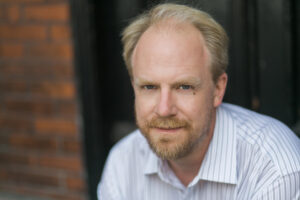
The Parker Quartet divine much from Gill’s 슬롯사이트 economy of means, transforming terse, even simple motives into a lingua franca for the listener to relish. Elements of familiarity are welcomed, as Gill’s sunny, near-hummable lines ring of truth and of beauty, distilled with a congenial dose of Americana. His carefully considered formal structures urge a dramatic, even theatrical, listening experience. Also finding folk aspects implicit to the string orchestra profile itself (cf. Tchaikovsky), Gill’s penchant for highlighting the concertino serves his purposes well; lower strings were especially punctuated. Some extended techniques proved effective throughout Motherwhere, often serving as percussive devices (ie. pizzicato, strumming and glissandi). The unison passages, while arresting, posed intonation challenges and became cumbersome, if not gritty.
Jeremy Gill’s vision of form, interaction and brightness of spirit must be thoroughly commended here. Through strength of artistic vision, technical expertise and familiarity with the commissioning ensemble, the composer has achieved a kind of cinematic, fictive musical world, jolly and inviting.
Equal enthusiasm for Zsófia Bán’s literary talent cannot be overstated. Indeed, her “bag-of-tales” might be requisite reading after this musical premiere. Bán herself mused on the “accidental encounter” that composer Gill had with her work. She likened it to “the clicking of two billiard balls on a global pool table.” And the entire performance at West 83rd Street, on this first April night in 2022, had that very air about it: a spirited, celebratory meeting of like-minded colleagues and friends. The specter of Antonio Vivaldi, with his ubiquitous provenance of “Spring,” saluted us too from on high.
NOTE: This concert review dates from a performance on Friday, April 1, 2022 at W83 Auditorium, New York
Handel: Enchantresses
Sandrine Piau, soprano
Les Paladins, Jérôme Correas, director
Alpha Classics
Soprano Sandrine Piau is a versatile artist who has compellingly performed a wide range of repertoire. Handel has remained a touchstone for Piau, and on Handel:Enchantresses, she explores a different subset of characters than the heroines and ingenues that were her bread and butter as a young singer. Handel is one of the great composers at illustrating grief, despair, and tempestuousness. The characters who inhabit these traits are given a showcase on this Alpha Classics CD.
Piau’s theatrical and expressive capabilities are on full display here. Rinaldo’s “Il Vostro Maggio,” a lament that is most touching, is delivered with considerable poignancy. Another lament, “Piangeró la Sorte Mia,” from Giulio Cesare in Egitto, alternates between aching appoggiaturas and a slow tempo in the outer sections and a middle section with fiery sixteenths. “Alla Salma Infedel,” from Lucrezia, is filled with closely spaced chromaticism, and Piau navigates her upper register with superlative control.
The soprano’s runs are fleet and clear, as evidenced on “Da Tempeste,” also from Guilio Cesare in Egitto, in which Cleopatra’s exults over her union with Julius Caesar. Sung with wide-ranging cadenzas and quickly rendered coloratura, this is tailor-made for Piau. “Scherza in mar la navicella,” from Lotario, is another showcase for fast-paced and wide-ranging singing that is as exciting as it is exactingly performed. “Ah! Mio cori,” from Alcina, is a riveting twelve-minute scena that features Piau’s singing at its most richly hued and dramatic.
Jérôme Correas leads Les Paladins with considerable flexibility, the ensemble turning on a dime to match Piau’s use of rubato. The instrumental pieces they present as interludes, excerpts from Concerto Grossos and the overture to Amadigi Di Gaulo, display Les Paladins to excellent advantage, playing nimble French overture rhythms in the overture and plangent dissonances in the G-minor concerto movement. They have a well balanced sound that is lustrous while being period-informed.
Some aria collections are grab bags or greatest hits recordings. Thoughtful curation is a welcome alternative that, happily, seems to have become more frequent. Handel: Enchantresses is ideal in this regard, in that it explores a different facet of Piau’s artistry while presenting arias that are, in many cases, underserved treasures. Highly recommended.
-Christian Carey

Magic&Unique Records has released Alien Music, a collection of the early works of Peter Thoegersen that combine alternate tuning with polytempic meters. With pieces dating from 2002, this album offers a baseline view of Thoegersen’s long-time exploration of the interrelationships between pitch and rhythm. As he writes in the liner notes: “Alien Music is essentially my first Polytempic Polymicrotonal piece composed from a four part drumset composition in four simultaneous meters/tempos: 3, 4, 5, 7, all played in one sitting. There are additional microtonal instruments added in different tunings: 12tet, 19tet, 7 tone slendro, and 5 tone pelog, tuned to parity with 7-limit just.”
The album consists of Alien Music and seven other tracks that incorporate a variety of experimental tunings, meters, different types of percussion, electronic sounds and even spoken phrases or chant. Thoegersen also includes original etudes and studies that reach back to the earliest realizations of his imaginative musical formulations. All the tracks on the album can be called alien in the sense that they sound otherworldly, but there is a double meaning in the album title: Thoegersen’s Polytempic Polymicrotonal music is also alien to all that has gone before it.
The title track, Alien Music, is perhaps the most developed piece of the collection. This opens with a steady percussive beat and an engaging microtonal melody in the marimba. Thoegersen’s crisp drumming weaves in and out of the texture, supported by an ambient wash in the deep background. The contrast of the frenetic drumming, cymbal crashes, marimba line and luminous bell tones with an undercurrent of languid strings is at once unsettling and engaging. The mixing is carefully crafted and does not unnecessarily favor any one element, allowing each to add to the total. The level of tension rises and falls as the piece proceeds, depending on what sounds are heard in the foreground. The active drumming subsides and then builds up in cycles and the ambient strings occasionally dominate to produce a mysterious feel. A nice groove develops in the percussion towards the finish and the piece ends with a soft bell tone that seems to hang in the air. For all its rhythmic and harmonic complexity, Alien Music holds together convincingly, with each unique element contributing to a cohesive and pleasing overall sound.
Other pieces on the album explore subsets of the polytempic and polymicrotonal possibilities that were incorporated into Alien Music. The shortest piece of the album is Polymicrotonality Etude VII, and this contains just an unintelligible echoed voice with bell microtones, one complimenting the other to create an increasingly anxious feel. Gorgeous Monstrosity, track 2, starts with a light tapping and scuffing, continually building to eventually include mechanical percussion and chimes. There is less integration of rhythm and pitch in this track but nevertheless it conveys a distinctively alien feel. Iraq, track 7, features more of Thoegersen’s solid drumming along with an almost conventional accompaniment of synthesized rock band and electronic keyboard. A sort of rough spoken rap is heard against a lyrical contrasting vocal line, and the ensemble works effectively to make a political statement critical of the invasion of Iraq. The other tracks of Alien Music are much like watching experiments in a laboratory, with each trying assess the potential of various combinations of ensemble, rhythm and tuning.
The impact of alternate tuning in contemporary music is still working itself out. Originally employed as a way to restore some character to the compromised conventional 12-tone equal temperament scale, alternate tuning has become a highly mathematical and theoretical discipline as well as an ongoing search for new harmonic syntax. Adding a polytempic component in addition to the microtone pitch set has been Thoegersen’s line of inquiry for over 20 years. His later works, such as Three Pieces in Polytempic Polymicrotonality from 2019, show a more mature handling of the polytempic polymicrotonal paradigm and are worth hearing for comparison. Alien Music provides a look into the origins of this system and gives us bright flashes of its future promise.
Alien Music is available for listening and download on Spotify.
Renowned bassist Jan Wobble (PIL) has joined with Ukrainian musicians to create a dub remix of the Ukrainian National Anthem. All proceeds will benefit Ukrainian Refugees. Please donate if you can.
LYRICS
Ukraine’s glory has not perished, nor her freedom gone
Our strong people, once again, fate will smile upon
All our enemies will soon disappear like dew in the sun
Then, once more will we be free, in the land we call our own
Body and soul we will lay down for our freedom
And the world will know that we are people of the Kozak nation
CREDITS
Produced by Jah Wobble and Jon Klein
Mixed and arranged by Jon Klein
Jah Wobble – bass
Jon Klein – guitar, keys and programming
‘The Legendary’ Len Liggins – lead vocal, backing vocal, violin
Peter Solowka – acoustic guitar, backing vocal
Paul Weatherhead – backing vocal, mandolin
Stephen ‘Mr Steff’ Tymruk – accordion
Jah Wobble cover photo by Paul Cliff
Video by Jon Klein and Rebecca Walkley; editing by Jon Klein
